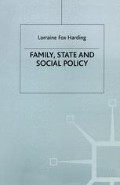Abstract
The last chapter looked at how family and state interact in key areas of social policy in Britain and considered the assumptions which policies appear to make about families, and the influence that policies might be argued to have on families (constraining, supporting, or facilitating forms of family life). The focus was on the areas in which state and family tend to interact, in the field which is broadly concerned with welfare. The state both controls and supports families, and the effects of various services on family life are mixed, setting parameters, facilitating certain patterns, making others more difficult, releasing family members from some burdens but adding and enforcing others, making certain options possible and others not possible, assuming patterns which may or may not be the case, reinforcing some ways of living but penalising others. Boundaries between state and family are often confused and contested, with ambiguous areas of responsibility. Where defined family ‘responsibilities’ are not met, the state may respond in a variety of ways. There is a power relationship between family and state, but the direction of influence is not just one way: families can affect how the state behaves, as well as being on the receiving end of its actions.
Preview
Unable to display preview. Download preview PDF.
Editor information
Copyright information
© 1996 Lorraine Harding
About this chapter
Cite this chapter
Harding, L.F. (1996). Models of the Family-State Relationship. In: Campling, J. (eds) Family, State and Social Policy. Palgrave, London. https://doi.org/10.1007/978-1-349-24377-8_5
Download citation
DOI: https://doi.org/10.1007/978-1-349-24377-8_5
Publisher Name: Palgrave, London
Print ISBN: 978-0-333-57482-9
Online ISBN: 978-1-349-24377-8
eBook Packages: Palgrave Social & Cultural Studies CollectionSocial Sciences (R0)

